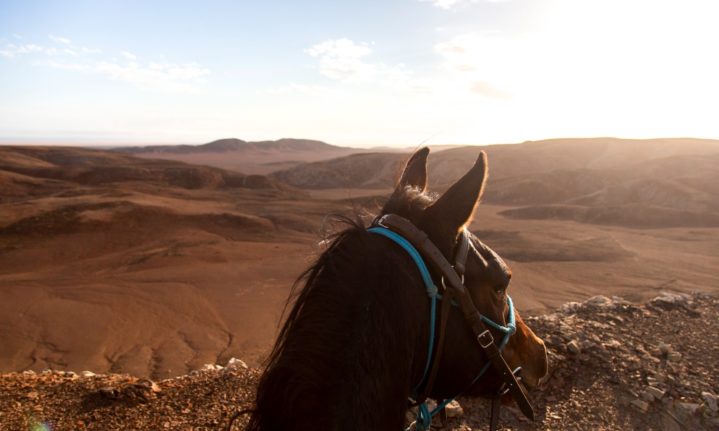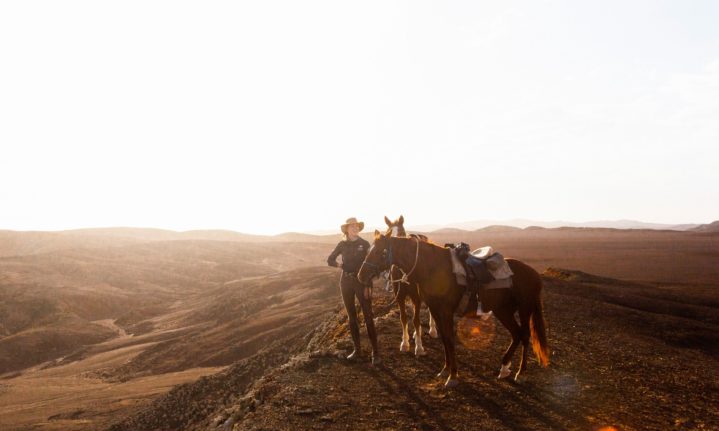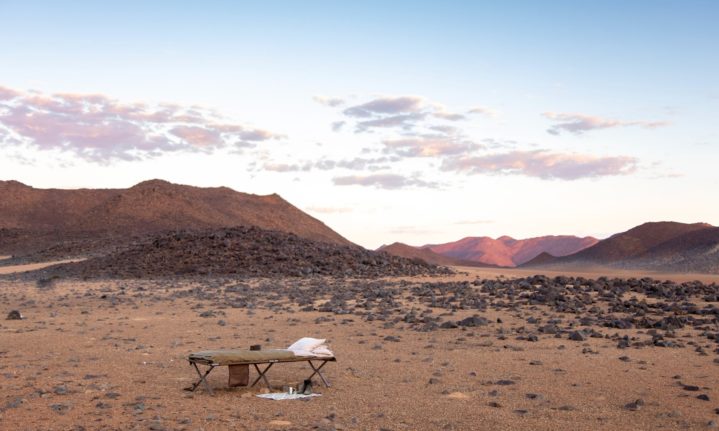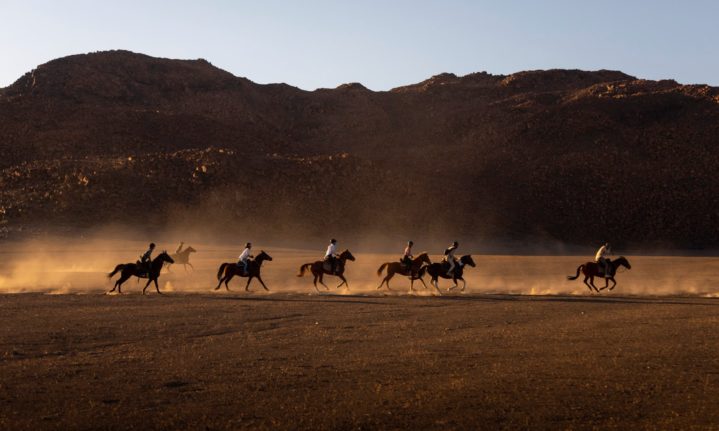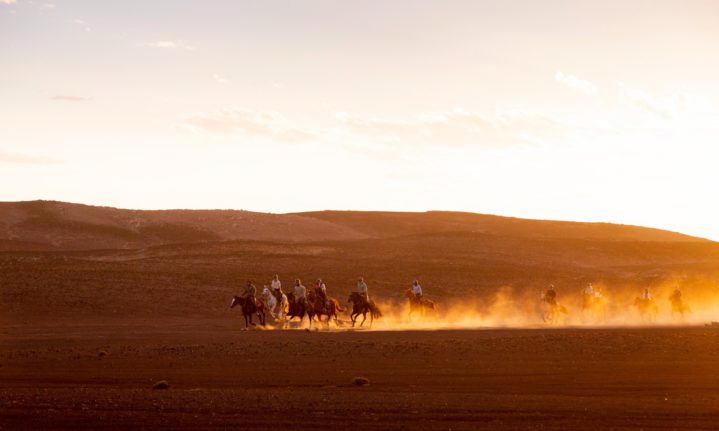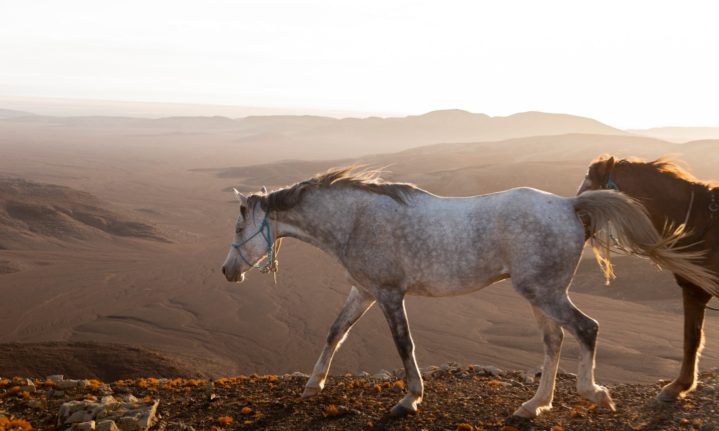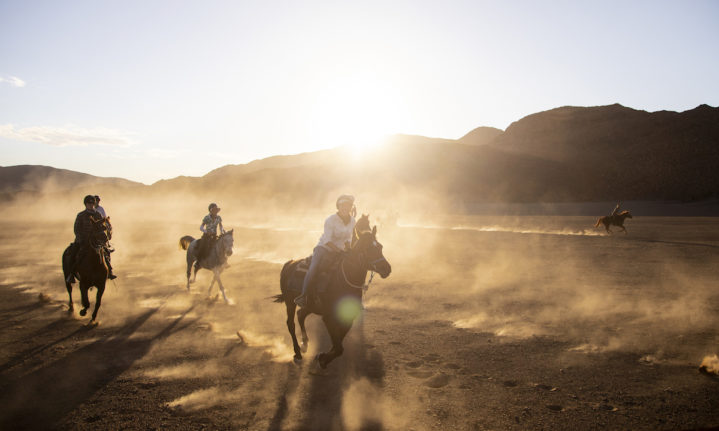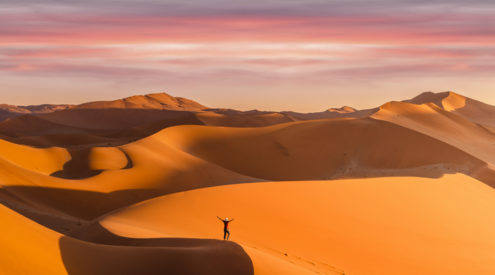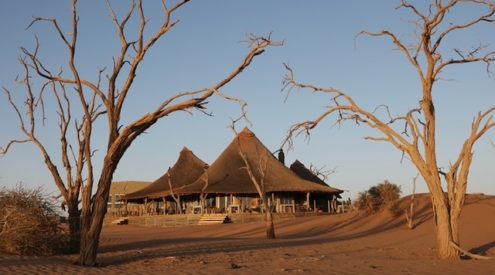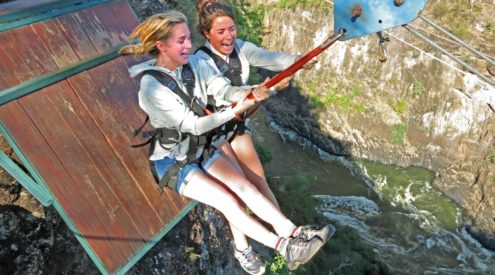Out in the desert expanse you’ll find a whole lot of nothing, and a whole lot of everything. Photographer Teagan Cunniffe joins a stalwart group of horse riders as they head towards the horizon
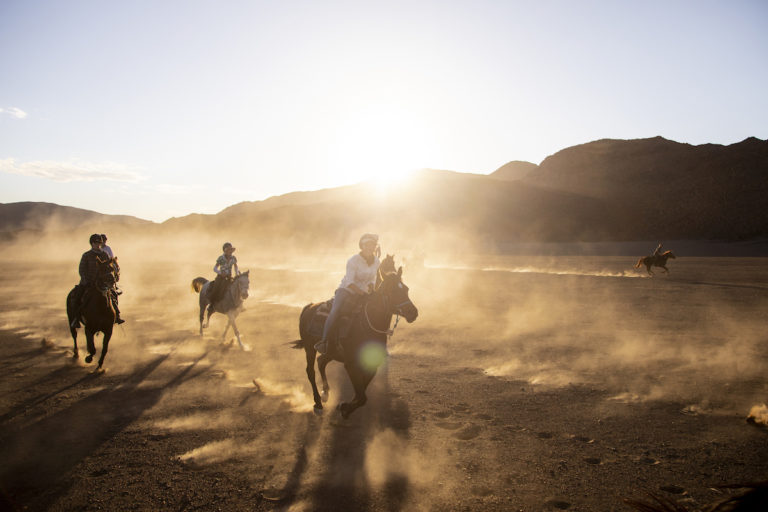
There’s only one rule for riding out in the lawless wastelands of the Skeleton Coast: stay on your horse. And it was being tested as 15 riders and two loose horses galloped in a ragged bunch, dirt powering from hooves and tears of exhilaration streaming from riders’ eyes and wild whooping filling the air.
Our horses felt the energy in the wacky race, had sensed it from the moment Andrew’s hand waved that slow, lazy circle and dropped, like a flag on a race track, and then it was every rider for themselves in the quest to see who was the fastest. Pounding hooves and outstretched necks yielded to an easier lope as one by one the horses gradually pulled away, slowing down, and a winner was revealed: young Jac on his home-bred Arabian, a dainty grey mare with arched neck and soft eyes. Jac beamed.
At 14 years old he is a skilled equestrian, with numerous competitive endurance riding kilometres under his belt. This win, sans trophy held aloft and spectators as witnesses, meant no less to him.
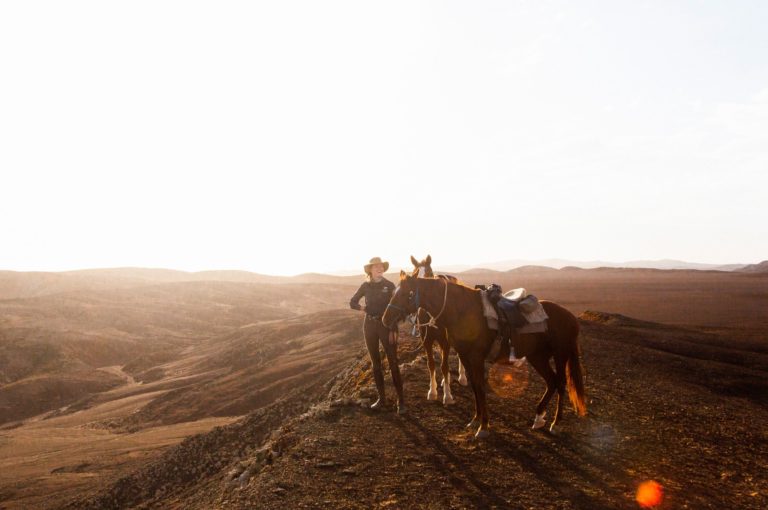
For as with any taxing, long-distance journey, you encounter physical and mental hurdles along the way. Some expected; more so, unexpected. Overcoming these challenges becomes your personal undertaking. This was Jac’s first multi-day horse trail without his parents, on his own horse. As for myself, I was gathering the courage to tackle riding bitless for the first time. I’d seen it done on previous trails, watching enviously as guests and crew alike had foregone using a bridle and bit. They’d effortlessly guided their horses with light rope pressures and body weight; the embodiment of freedom. There is a catch though, for to shed the ‘essential’ bridle, you first need to shed the fear of losing control.
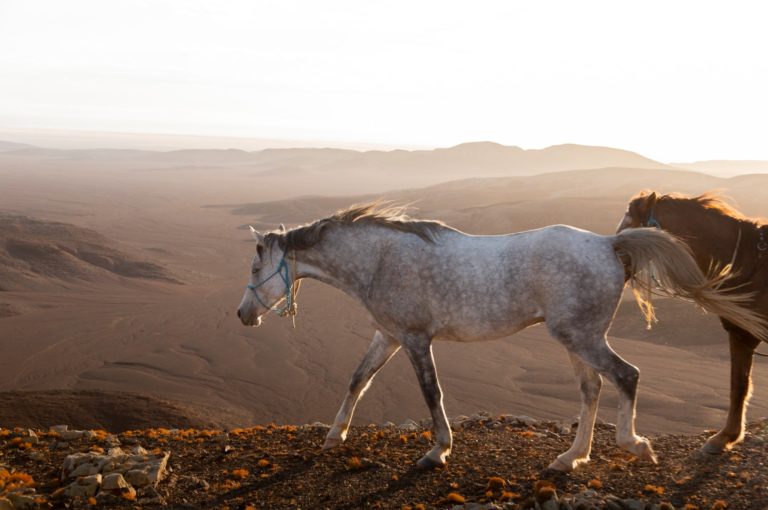
‘Well, where can Habanero go, if he does run off?’ Andrew said sagely. He gestured to the monochromatic gravel landscape surrounding us, expanding soundlessly in a grey uniformity, a smattering of white quartz outcrops, and the horizontal slash of a fog-filled sky so typical of the desolate Skeleton Coast. Habanero, my dark bay horse, was a relative youngster at six years old but steady of nature. ‘Why don’t you give it a try.’
Andrew Gillies, lead guide, expert horseman and co-owner of the inimitable Namibia Horse Safari Company, gave a nonplussed shrug; he didn’t mind either way. However, I did, and my timidity rankled. The only one holding me back was myself.
Our five-day route, curated and sold by adventurous horse safari agency Ride the Wild, had started off in the Skeleton Coast National Park where the rib cages of shipwrecks lay picked clean by time and black-backed jackals scavenged for scraps off seal carcasses. We’d left behind the ramshackle ‘civilisation’ of our first campsite, St Nowhere, and rode inland over lichen plains that rose to meet plunging canyons.
We worked our way deeper into the Dorob National Park, covering between 20km and 40km in four to seven hours of riding each day with a 200km route that hooked back towards the coast, ending at Hentiesbaai. Long days in the saddle were countered by hot bucket showers and fire-cooked meals by the unflappably talented chef Rayne Brehm. Mugs of whisky around the fire faded into warm bedrolls underneath star-filled skies, then merged with soft-hued dawns accompanied by freshly brewed coffee, pot-baked bread and the snort of horses along the picket line as they greedily tucked into nose bags.
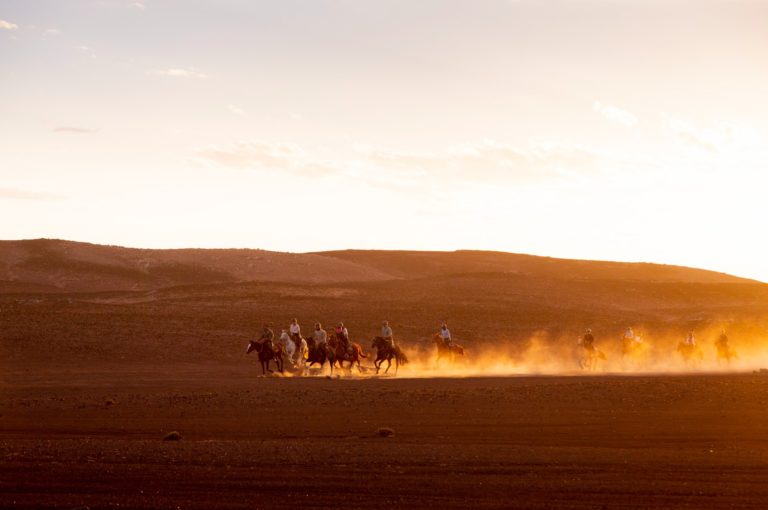
Day three
the wind stilled. Temperatures increased, pooling the heat into wet mirages until it felt like we were sloshing forward through air made heavier by our own sweat. Tracks of a lone black rhino appeared to our right, crossing our path in a meandering wander.
With zero water or signs of plant life, we could only hypothesise how it could survive. Fit horses carried us in relentless, ground-eating strides as we surrendered to their leadership and sat, wilted, on their backs for time interminable. We rounded a corner, and as is common in Namibia, the landscape simply changed.
Crunching calcrete rock became fine gravel scattered with orange citrine crystals. Our horses’ ears pricked forward. Ahead, the shimmering air resolved into an oasis of a different sort: the safari’s 18-wheeler truck, where lunch and rest awaited. Gin and tonics were handed around and like the rains of the desert, these withered souls began to show signs of life.
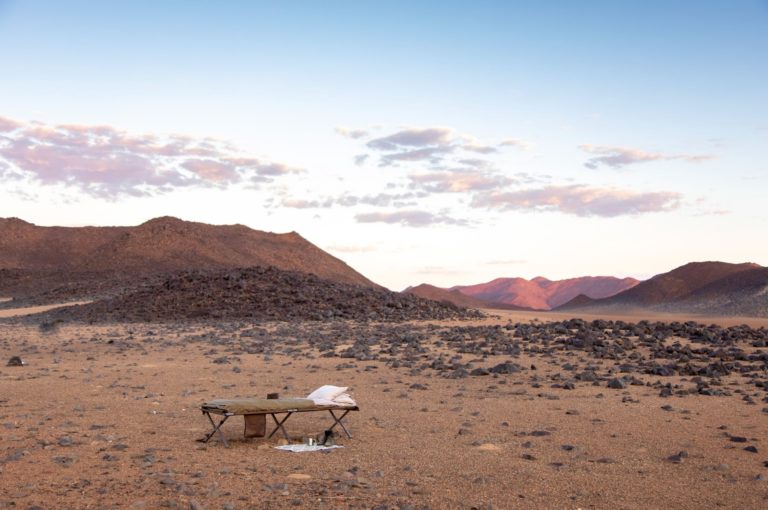
Day four
we scaled the highest outer rim of the Messum Crater, tacking our way up in single file as the wind tugged at the horses’ tails, stealing our hats from our heads and the words from our lips. Strewn before us was a panorama straight from a film set; nothingness stretching as far as the eye could see.
I maintain there’s only so much beauty one can physically take before being overcome by giddiness, and we had reached saturation point. Descending down the mountain to the sanded floor below, we picked up speed to a buoyant canter and raced with abandon through the land before us, our tracks crisscrossing those of oryx and zebra. With good horses underneath us, a supply crew before us, why, we could ride on forever! Yet as pioneering as we felt, others had tread this ground long before. Here were other signs of humanity for those who knew where to look.
‘These rock structures were used as hides by Khoisan hunter-gatherers. If you can see where the oryx tracks go… there?’ Andrew said, pointing, ‘that’s the easiest route for the animals to pass between these sand dunes. The Khoisan knew that, and would build hides within arrow-reach.’
The juxtaposition between worlds impressed upon me as I hunkered down on a rock and imagined determined, sun-wizened hunters waiting under the same sky, sitting on the same sharp rocks. The self-resilience required for anyone to survive out here, far from any discernible water source, was overwhelmingly brave.
Habanero dosed amiably, his head drooped down low and bottom lip hanging slack against my leg. I scratched his ears quietly – and then slipped off his bridle.
Six to 10-day Namibian trails can be booked through Ride the Wild, which specialises in custom horse safari holidays for a range of budgets.
This article originally appeared in the February 2022 print edition of Getaway
Words and photos by Teagan Cunniffe
DEAL: A Horse riding experience for 2 in Rayton
Follow us on social media for more travel news, inspiration, and guides. You can also tag us to be featured.
TikTok | Instagram | Facebook | Twitter
ALSO READ: Rambo’s redfin mission: a quest for an endangered fish









